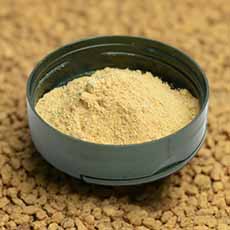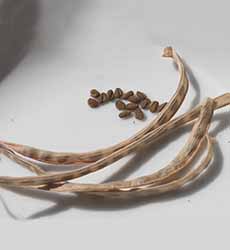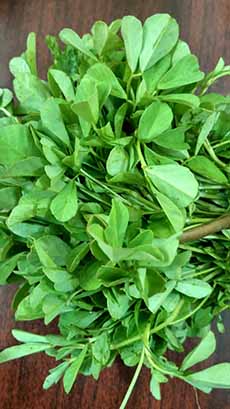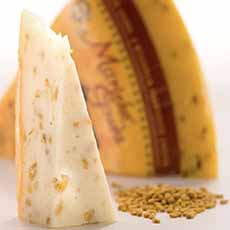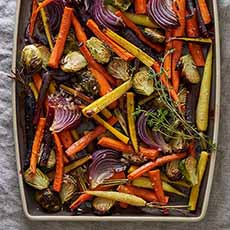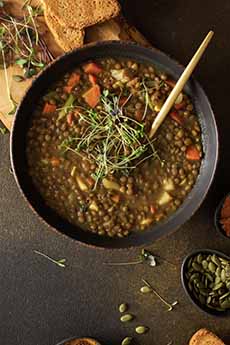Try A New (But Ancient) Spice: Hilba a.k.a. Fenugreek
|
|
If you like to try new flavors when you cook, it’s time to spice things up with a little-known (in the U.S.) spice superstar: hilba (or hilbeh—the Arabic name), also known as fenugreek (derived from the Latin faenugraecum, meaning “Greek hay”). The plant’s leaves and seeds are common ingredients in dishes from the Indian subcontinent and have been a staple in Middle Eastern and Mediterranean cuisines. > The difference between herbs and spices. There are often many different names for a product, based on the number of languages of the peoples who use it. Because Pereg Gourmet Spices, which inspired this article, uses the Middle Eastern name, we’ll use the terms interchangeably. Hilba packs a flavor punch of warm, sweet, and slightly bitter notes. “It adds a depth of taste that will leave your taste buds dancing,” says Pereg, which re-introduced us to the spice, which we hadn’t had in decades. The flavor of fenugreek seeds can be bitter by itself but when cooked into a dish it adds a slightly nutty sweetness similar to notes of burnt sugar or maple syrup. You can toast them lightly, but not too much or the heat will add bitterness. > How to toast spices, nuts, and seeds. Ready to embark on a flavor adventure? Hilba is incredibly versatile. Sprinkle it on meats, stir it into soups, or add it to your favorite dips. > See the recipes below. The Pereg line is gluten-free, GMO-free, certified kosher by OU, and verified CRC kosher. Fenugreek is a “triple-threat,” used as an herb (dried or fresh leaves), a spice (seeds or ground seeds—photo #2), and a vegetable (fresh leaves—photo #4—sprouts, and microgreens). It has a distinctive maple syrup aroma from the chemical compound sotolon (which also gives the same aroma to lovage). The seeds are often roasted first, which enhances the flavor and reduces inherent bitterness. Here’s how the spice is used in global cuisines [source]. Armenia: Fenugreek seed powder is used to make a coating paste for basturma (pastirma), air-dried beef. The dish is also found in Albania, Armenia, Romania, Bulgaria, Egypt, Greece, Cyprus, Iraq, the Levant, North Macedonia, Azerbaijan, and Turkey. Egypt: Fenugreek is known by the Arabic name hilba or helba. Seeds are boiled to make a drink that is consumed at home, as well as in coffee shops. Farmers in Upper Egypt add fenugreek seeds and maize to pita dough to produce aish merahrah, a staple of their diet. Eritrea and Ethiopia: The word for fenugreek in Amharic is abesh or abish. In addition to a culinary spice, the seed is used as an herbal medicine to treat diabetes. Georgia: The cuisine uses a related species, Trigonella caerulea, known as “blue fenugreek.” India: Fenugreek seeds are used both whole and powdered in the preparation of dal, pickles, vegetable dishes, and spice mixes such as panch phoron (Indian Five Spice Blend) and sambar powder (a spice blend of coriander seeds, Bengal gram dal, dried chiles, fenugreek, pepper, pigeon pea dal, and turmeric powder). Fresh fenugreek leaves are an ingredient in some curries, and in potatoes dishes such as aloo methi (which means “potato fenugreek”). Iran: Fenugreek leaves, called shambalileh, are one of several greens incorporated into the herb stew ghormeh sabzi, the herb frittata kuku sabzi and the soup known as eshkeneh. Morocco: Fenugreek is used in rfissa, a noteworthy stew of chicken, lentils, and onions served on a bed of shredded msemen flatbread or trid (a.k.a. b’stilla, a paper-thin pastry in the manner of phyllo). Turkiye: The spice is very popular for basturma/pastirma (air-dried beef). The name comes from the Turkish verb bastırmak, meaning “to press.” Yemen: A small amount of oud† al hilba (ashwagandha in India) is traditionally added to ground fenugreek seeds, then mixed with water to create a paste called hulbah. It is believed to aid in digestion and perhaps more importantly for Yemenites, lessens or eliminates the maple syrup smell. Yemenite Jewish: Sephardic Jews in Yemen grind the seeds and mix them with water, where they greatly expand. Hot chile spice, turmeric and lemon juice are added to produce a frothy relish called hilbeh, which eaten with a sop (e.g. bread) for the Jewish New Year, Rosh Hashanah. It is eaten daily and ceremonially during dinner on the first and/or second night of the holiday. Wild members of the genus grow wild in the Canary Islands, southern Europe, non‑tropical Africa, western and central Asia, the Indian subcontinent, and Australia. Hilba/fenugreek is a member of the Fabaceae (Leguminosae) botanical family, commonly known as the legume, pea, or bean family. It’a a large and agriculturally important family of flowering plants, the third-largest* land plant family with nearly 20,000 known species. Charred fenugreek seeds, carbon dated to 4000 B.C.E., have been recovered from Tell Halal, Iraq and Tel Lachish, a Bronze Age settlement in Israel. Desiccated seeds were also found in the tomb of Tutankhamen, the “boy king” (c. 1341 B.C.E. to c. 1323 B.C.E.). Much later, Cato the Elder (149-149 B.C.E.) cited fenugreek with clover and vetch as crops grown to feed cattle [source]. Moving to first century C.E., we find that the Romans flavored wine with fenugreek; and in Galilee, Josephus notes that it was grown as a staple food [source]. |
|
|
EASY RECIPES WITH HILBA / FENUGREEK Discover a whole new world of flavor! †An aromatic resin—think of other edible tree resins like mastic. CHECK OUT WHAT’S HAPPENING ON OUR HOME PAGE, THENIBBLE.COM. |
||

